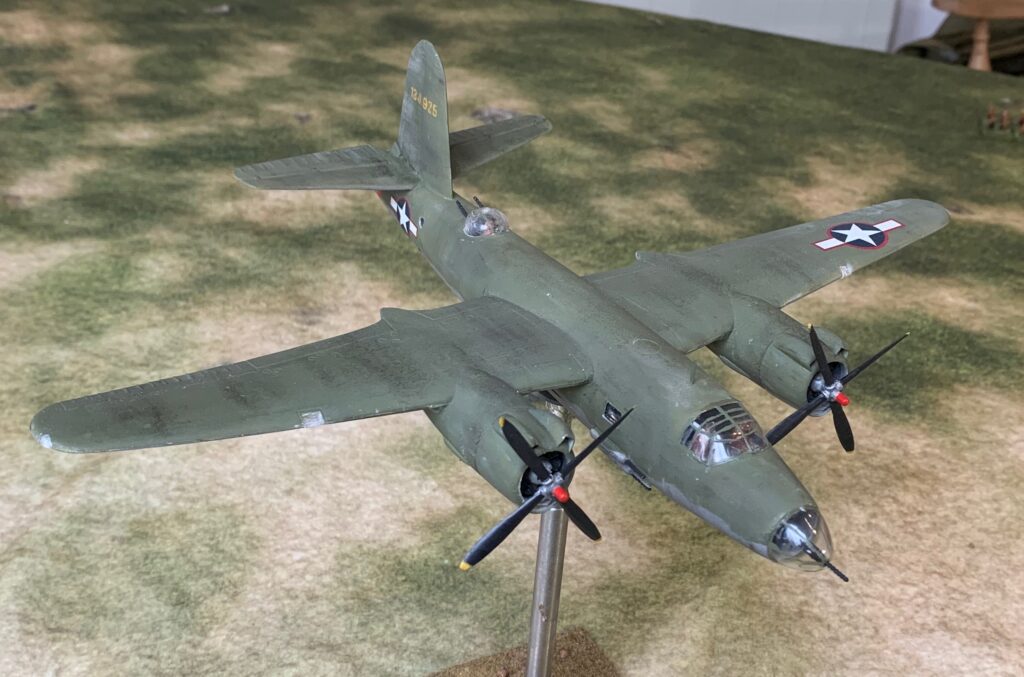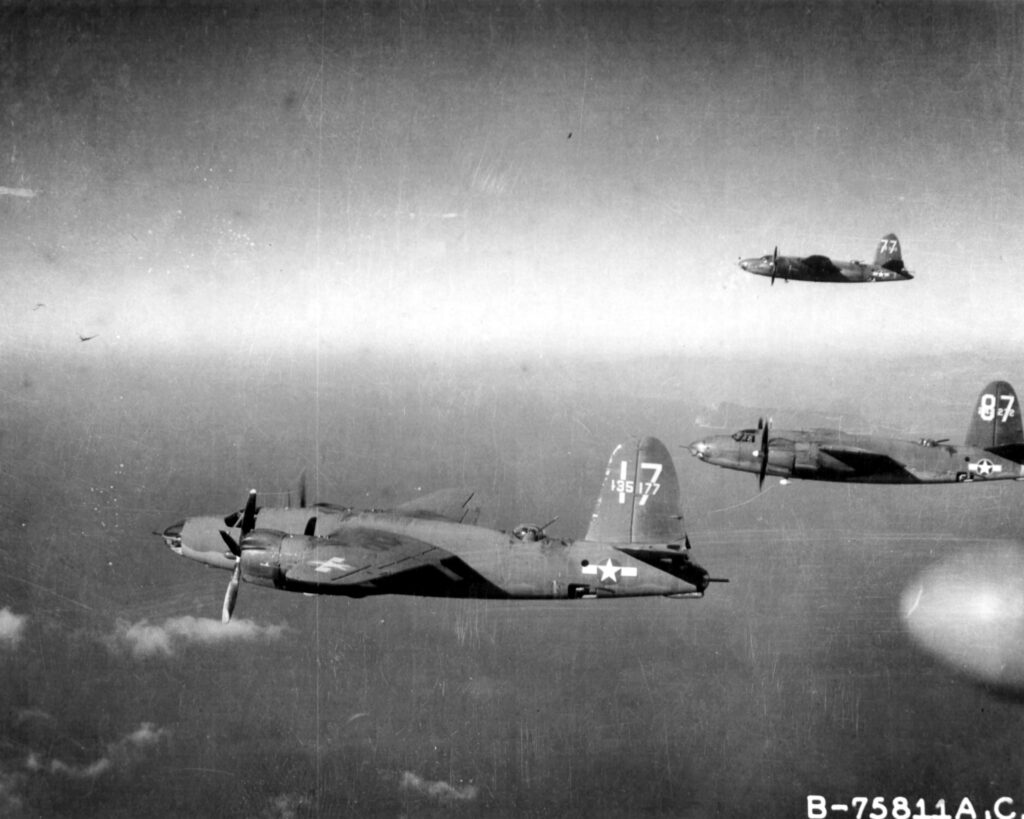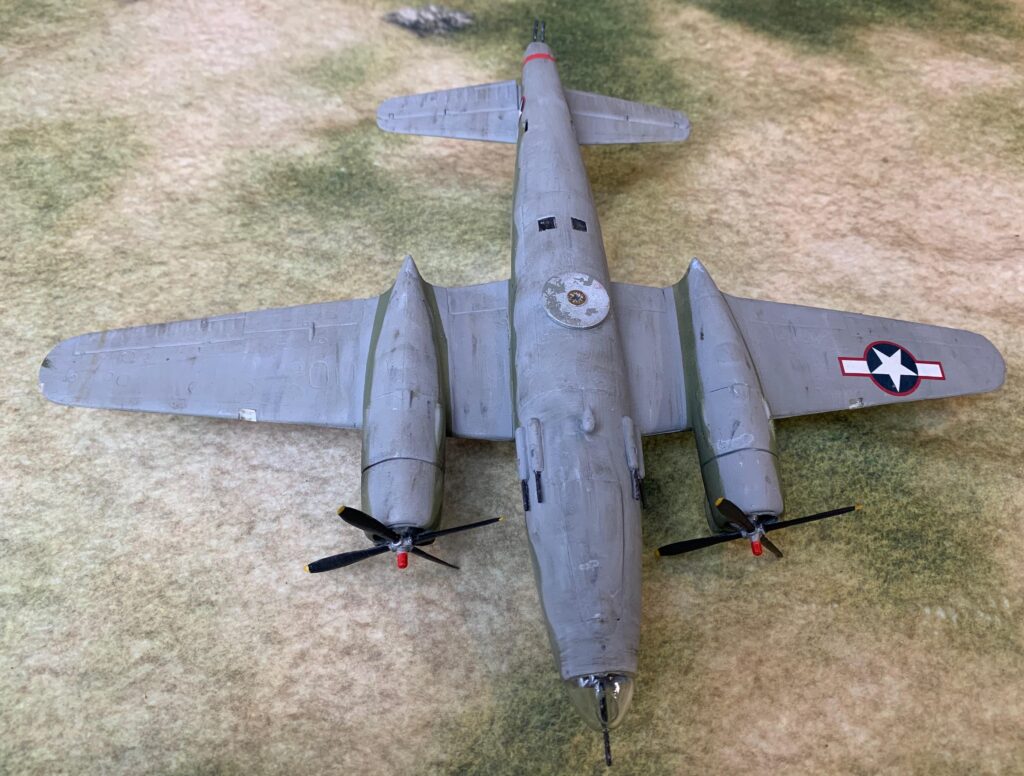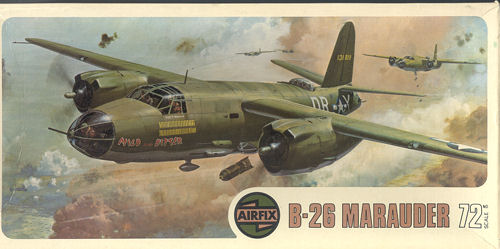The first of my latest batch of aircraft models for to describe individually is the B-26. I bought this kit back in the late 1970s, as a gift to my younger brother. But he was losing interest in modelling and left it in my parents’ attic, from whence I rescued it during one the their periodic clear-outs as they moved and downsized. Since then it lurked in my attic. After moving house in 2020 I decided that I was going to assemble this model – indeed it sowed the seed of the idea of my 1943 aircraft project. I have always liked this aircraft.
Along with the B-25 Mitchell, the B-26 Marauder was one of the two principal medium bomber types in US service in WW2. More B-25s were produced, and many more survive today – but, apparently, more of the B-26s were in use in the European theatre. That is certainly true of the Mediterranean in 1943 – three bomber groups were in operation, compared to two for the B-25. The B-25 had a longer range, and so more useful in the Pacific, I read. Still Catch-22, set in the Med, featured the B-25. The B-26 had a bit of a tricky reputation, as it required quite a high landing speed – and there were quite a few accidents in the early days. Tweaks to the design, and better training, overcame the problems, however, and the overall casualty rate was lower than the B-25 in the end. I guess that was because it was faster, and so harder to intercept. Anyway, to my eye it is much better looking, with its cigar-shaped fuselage, compared to the boxy B-25.
I wanted to make an aircraft as it would have appeared in September 1943, when B-26s supported the Salerno battle. That meant a plain olive drab and grey scheme, and no large battle number on the tail – so characteristic of later on (they were introduced a month or so after Salerno). The insignia had the red outline. I wanted to depict an actual aircraft, where I was limited by two main factors. First, the model depicts a later variant, with a distinctly different tail gun position (and may be differences too). That ruled out quite a few planes in operation in 1943. Second I wanted to be able to make up the tail numbers from as few sources as possible, including the original Airfix decals. This pointed me at number 41-34925 “Kismet” from 37th Squadron of 17th Bombardment Group. This plane survived the war, completing many missions. One tricky issue was nose art, which I was really not keen to get into. The illustration I found from Mark Styling showed this plane with quite simple nose art (apart from the many mission markers visible in later line). It has the word “Kismet” with further words “Sine Qua Non” in a curve below – all quite small and in yellow lettering. No cartoon characters, bombs or busty ladies. This would not have been impossible for me to put together and print off, though yellow printer ink would not have come out strongly without a bit of white ink to give it body – but I didn’t fancy doing it. Besides I noticed on pictures of planes in action in 1943 that nose art was often absent (see below) – so the model has nothing.

The first stage of the project was to paint and assemble the interior. The model came with three crew figures: two for the cockpit and one for the gun turret. I had already used on of the cockpit figures for my P-47, and since the remaining one would not have looked right next to one of the PJ figures, I put two from PJ in the cockpit. The turret figure was quite crude, with a huge circulardvice in place of his hands to provide a pivot for the guns. I decided to keep it, and in faction can’t see much through the turret plastic, so this didn’t matter. The online sources did not give any consistent colour for the interior, though it is usually represented as green – a mix with the chrome-yellow primer in use. I decided to follow another source, which said it was a mix of black and treated aluminium. You can barely see it though! The transparencies are quite thick, so visibility is not perhaps what it should be.
Assembly came next. This was much easier than for my P-38 model – the fit was generally OK, and there were lugs and recesses to hold parts in the right relative positions. Still it was not as tight as some more modern kits that I have assembled – though not the other two in this batch. I should have spent a bit more time filing down parts to get the fit a bit tighter, especially the bomb doors and the engine nacelles. Fairly liberal amounts of filler were needed in places, causing some of the panelling detail to be lost. – and I needed to use tape to keep the fuselage together while the cement was setting. One issue worth mentioning was transparencies. Except at the rear and nose I stuck these in before painting. The cockpit canopy because I wanted to use filler to ensure a seamless join with the fuselage; the various portholes, etc. because they had to be stuck in from the inside, and the turret because it looked too tricky to do later. These had to be masked. The main problem was that I used specialist glue for canopies – after problems with superglue causing damage – and these had weaker adhesive properties than I was used to. One of the side windows fell into the body of the fuselage, and could not be recovered. I had to bodge a replacement carved from sprue. I had to do something similar to one of the wing lights which I dropped on the floor and couldn’t find. Incidentally in the kit there are windows for the two openings at the bottom back of the fuselage, just under the tailplanes. In 1943 these openings were ports for a machinegun, so I left the transparencies out – though I did not attempt to show include the weapon.

I have already outlined the strategy for painting and finishing. The decals required were minimal. I got the national insignia with the red outlines from eBay. The tail numbers were a combination from the original model and an ancient Airfix P-47 kit (which were slightly duller – which I tried to correct with a bit of yellow paint). The overall result is a bit darker and greener than often depicted (for example in the box art above) – though I think the artificial light mixed in with the natural light in the picture makes it a bit greener. It is meant to show a relatively new plane, not quite as weathered as normal. Here is a new contemporary picture of planes from 17 BG in flight:

These are planes returning from a raid on Sardinia in November 1943, shortly after the big battle numbers on the tail were added; No. 17 (Uden Uden’s Oil Burner) has a damaged engine from flak and is limping home, escorted by the others (from a different squadron) – it did make it to safety and went on the complete many more missions. Both it and 97 behind it were candidates for my model, but the tail numbers weren’t as easy to source. Incidentally I can’t see any nose art on either the plane – though the front plane at least was photographed later in the war with nose are on both sides. Sometimes it was just on the port side. This picture shows the slightly weather-beaten matt look, with not much contrast between the olive drab and grey. No 17 has a lot of paint damage on the tail, but not much elsewhere.
And here’s the underside:

The weathering is a bit heavy-handed – but I have no photos of what it would have looked like in practice. The underside did get a hammering from the dust airstrips – but I don’t know how that looked!
There’s plenty on the model that could have been done better – but I’m glad its decades in the attic weren’t in vain!
